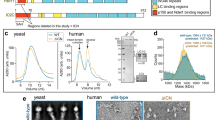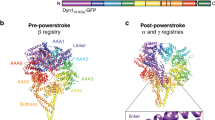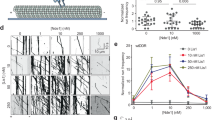Abstract
Dynactin is the longest known cytoplasmic dynein regulator, with roles in dynein recruitment to subcellular cargo and in stimulating processive dynein movement. The latter function was thought to involve the N-terminal microtubule-binding region of the major dynactin polypeptide p150Glued, although recent results disputed this. To understand how dynactin regulates dynein we generated recombinant fragments of the N-terminal half of p150Glued. We find that the dynein-binding coiled-coil α-helical domain CC1B is sufficient to stimulate dynein processivity, which it accomplishes by increasing average dynein step size and forward-step frequency, while decreasing lateral stepping and microtubule detachment. In contrast, the immediate upstream coiled-coil domain, CC1A, activates a surprising diffusive dynein state. CC1A interacts physically with CC1B and interferes with its effect on dynein processivity. We also identify a role for the N-terminal portion of p150Glued in coordinating these activities. Our results reveal an unexpected form of long-range allosteric control of dynein motor function by internal p150Glued sequences, and evidence for p150Glued autoregulation.
This is a preview of subscription content, access via your institution
Access options
Subscribe to this journal
Receive 12 print issues and online access
$209.00 per year
only $17.42 per issue
Buy this article
- Purchase on Springer Link
- Instant access to full article PDF
Prices may be subject to local taxes which are calculated during checkout






Similar content being viewed by others
References
Vallee, R. B., McKenney, R. J. & Ori-McKenney, K. M. Multiple modes of cytoplasmic dynein regulation. Nat. Cell Biol. 14, 224–230 (2012).
McKenney, R. J., Vershinin, M., Kunwar, A., Vallee, R. B. & Gross, S. P. LIS1 and NudE induce a persistent dynein force-producing state. Cell 141, 304–314 (2010).
Huang, J., Roberts, A. J., Leschziner, A. E. & Reck-Peterson, S. L. Lis1 acts as a “Clutch” between the ATPase and microtubule-binding domains of the dynein motor. Cell 150, 975–986 (2012).
Schroer, T. A. Dynactin. Annu. Rev. Cell Dev. Biol. 20, 759–779 (2004).
Echeverri, C. J., Paschal, B. M., Vaughan, K. T. & Vallee, R. B. Molecular characterization of the 50-kD subunit of dynactin reveals function for the complex in chromosome alignment and spindle organization during mitosis. J. Cell Biol. 132, 617–633 (1996).
Holleran, E. A., Tokito, M. K., Karki, S. & Holzbaur, E. L. Centractin (ARP1) associates with spectrin revealing a potential mechanism to link dynactin to intracellular organelles. J. Cell Biol. 135, 1815–1829 (1996).
King, S. J. & Schroer, T. A. Dynactin increases the processivity of the cytoplasmic dynein motor. Nat. Cell Biol. 2, 20–24 (2000).
Culver-Hanlon, T. L., Lex, S. A., Stephens, A. D., Quintyne, N. J. & King, S. J. A microtubule-binding domain in dynactin increases dynein processivity by skating along microtubules. Nat. Cell Biol. 8, 264–270 (2006).
Kardon, J. R., Reck-Peterson, S. L. & Vale, R. D. Regulation of the processivity and intracellular localization of Saccharomyces cerevisiae dynein by dynactin. Proc. Natl Acad. Sci. USA 106, 5669–5674 (2009).
Holzbaur, E. L. F. et al. Homology of a 150K cytoplasmic dynein-associated polypeptide with the Drosophila gene Glued. Nature 351, 579–583 (1991).
Vaughan, K. T. & Vallee, R. B. Cytoplasmic dynein binds dynactin through a direct interaction between the intermediate chains and p150Glued. J. Cell Biol. 131, 1507–1516 (1995).
Waterman-Storer, C. M., Karki, S. & Holzbaur, E. L. The p150Glued component of the dynactin complex binds to both microtubules and the actin-related protein centractin (Arp-1). Proc. Natl Acad. Sci. USA 92, 1634–1638 (1995).
Vaughan, P. S., Miura, P., Henderson, M., Byrne, B. & Vaughan, K. T. A role for regulated binding of p150(Glued) to microtubule plus ends in organelle transport. J. Cell Biol. 158, 305–319 (2002).
Watson, P. & Stephens, D. J. Microtubule plus-end loading of p150Glued is mediated by EB1 and CLIP-170 but is not required for intracellular membrane traffic in mammalian cells. J. Cell Sci. 119, 2758–2767 (2006).
Dixit, R., Levy, J. R., Tokito, M., Ligon, L. A. & Holzbaur, E. L. F. Regulation of dynactin through the differential expression of p150(Glued) isoforms. J. Biol. Chem. 283, 33611–33619 (2008).
Kim, H. et al. Microtubule binding by dynactin is required for microtubule organization but not cargo transport. J. Cell Biol. 176, 641–651 (2007).
Moughamian, A. J. & Holzbaur, E. L. Dynactin is required for transport initiation from the distal axon. Neuron 74, 331–343 (2012).
Lloyd, T. E. et al. The p150(Glued) CAP-Gly domain regulates initiation of retrograde transport at synaptic termini. Neuron 74, 344–360 (2012).
Gross, S. P., Welte, M. A., Block, S. M. & Wieschaus, E. F. Coordination of opposite-polarity microtubule motors. J. Cell Biol. 156, 715–724 (2002).
Haghnia, M. et al. Dynactin is required for coordinated bidirectional motility, but not for dynein membrane attachment. Mol. Biol. Cell 18, 2081–2089 (2007).
McKenney, R. J., Weil, S. J., Scherer, J. & Vallee, R. B. Mutually exclusive cytoplasmic dynein regulation by NudE-Lis1 and dynactin. J. Biol. Chem. 286, 39615–39622 (2011).
Siglin, A. E. et al. Dynein and dynactin leverage their bivalent character to form a high-affinity interaction. PLoS ONE 8, e59453 (2013).
Lau, S. Y., Taneja, A. K. & Hodges, R. S. Synthesis of a model protein of defined secondary and quaternary structure. Effect of chain length on the stabilization and formation of two-stranded alpha-helical coiled-coils. J. Biol. Chem. 259, 13253–13261 (1984).
Ross, J. L., Wallace, K., Shuman, H., Goldman, Y. E. & Holzbaur, E. L. F. Processive bidirectional motion of dynein–dynactin complexes in vitro. Nat. Cell Biol. 8, 562–570 (2006).
Mallik, R., Carter, B. C., Lex, S. A., King, S. J. & Gross, S. P. Cytoplasmic dynein functions as a gear in response to load. Nature 427, 649–652 (2004).
Wang, Z., Khan, S. & Sheetz, M. P. Single cytoplasmic dynein molecule movements: characterization and comparison with kinesin. Biophys. J. 69, 2011–2023 (1995).
Tokito, M. K., Howland, D. S., Lee, V. M. & Holzbaur, E. L. Functionally distinct isoforms of dynactin are expressed in human neurons. Mol. Biol. Cell 7, 1167–1180 (1996).
Quintyne, N. J. et al. Dynactin is required for microtubule anchoring at centrosomes. J. Cell Biol. 147, 321–334 (1999).
Morgan, J. L., Song, Y. & Barbar, E. Structural dynamics and multiregion interactions in dynein–dynactin recognition. J. Biol. Chem. 286, 39349–39359 (2011).
Ori-McKenney, K. M., Xu, J., Gross, S. P. & Vallee, R. B. A cytoplasmic dynein tail mutation impairs motor processivity. Nat. Cell Biol. 12, 1228–1234 (2010).
DeWitt, M. A., Chang, A. Y., Combs, P. A. & Yildiz, A. Cytoplasmic dynein moves through uncoordinated stepping of the AAA + ring domains. Science 335, 221–225 (2012).
Qiu, W. et al. Dynein achieves processive motion using both stochastic and coordinated stepping. Nat. Struct. Mol. Biol. 19, 193–200 (2012).
Weisbrich, A. et al. Structure–function relationship of CAP-Gly domains. Nat. Struct. Mol. Biol. 14, 959–967 (2007).
Rao, L. et al. The yeast dynein Dyn2-Pac11 complex is a dynein dimerization/processivity factor: structural and single-molecule characterization. Mol. Biol. Cell 24, 2362–2377 (2013).
Ananthanarayanan, V. et al. Dynein motion switches from diffusive to directed upon cortical anchoring. Cell 153, 1526–1536 (2013).
Tang, X., Germain, B. S. & Lee, W-L. A novel patch assembly domain in Num1 mediates dynein anchoring at the cortex during spindle positioning. J. Cell Biol. 196, 743–756 (2012).
Scherer, J, Yi, J. & Vallee, R. B. PKA-dependent dynein cargo switching from lysosomes to adenovirus: a novel form of host-virus competition. J. Cell Biol. 205, 163–177 (2014).
Schlager, M. A., Hoang, H. T., Urnavicius, L., Bullock, S. L. & Carter, A. P. In vitro reconstitution of a highly processive recombinant human dynein complex. EMBO J. 33, 1855–1868 (2014).
McKenney, R. J., Huynh, W., Tanenbaum, M. E., Bhabha, G. & Vale, R. D. Activation of cytoplasmic dynein motility by dynactin-cargo adapter complexes. Science 345, 337–341 (2014).
Paschal, B. M. et al. Characterization of a 50-kDa polypeptide in cytoplasmic dynein preparations reveals a complex with p150GLUED and a novel actin. J. Biol. Chem. 268, 15318–15323 (1993).
Yi, J. Y. et al. High-resolution imaging reveals indirect coordination of opposite motors and a role for LIS1 in high-load axonal transport. J. Cell Biol. 195, 193–201 (2011).
Bremner, K. H. et al. Adenovirus transport via direct interaction of cytoplasmic dynein with the viral capsid hexon subunit. Cell Host Microbe 6, 523–535 (2009).
Sigua, R., Tripathy, S., Anand, P. & Gross, S. P. Isolation and purification of kinesin from Drosophila embryos. J. Vis. Exp. (2012).
Paschal, B. M., Shpetner, H. S. & Vallee, R. B. Purification of brain cytoplasmic dynein and characterization of its in vitro properties. Methods Enzymol. 196, 181–191 (1991).
Mikami, A. et al. Molecular structure of cytoplasmic dynein 2 and its distribution in neuronal and ciliated cells. J. Cell Sci. 115, 4801–4808 (2002).
Bohm, K. J., Stracke, R. & Unger, E. Speeding up kinesin-driven microtubule gliding in vitro by variation of cofactor composition and physicochemical parameters. Cell Biol. Int. 24, 335–341 (2000).
Kelly, S. M., Jess, T. J. & Price, N. C. How to study proteins by circular dichroism. Biochim. Biophys. Acta 1751, 119–139 (2005).
Kunwar, A. et al. Mechanical stochastic tug-of-war models cannot explain bidirectional lipid-droplet transport. Proc. Natl Acad. Sci. USA 108, 18960–18965 (2011).
Svoboda, K. & Block, S. M. Force and velocity measured for single kinesin molecules. Cell 77, 773–784 (1994).
Vershinin, M., Carter, B. C., Razafsky, D. S., King, S. J. & Gross, S. P. Multiple-motor based transport and its regulation by Tau. Proc. Natl Acad. Sci. USA 104, 87–92 (2007).
Mallik, R., Petrov, D., Lex, S. A., King, S. J. & Gross, S. P. Building complexity: an in vitro study of cytoplasmic dynein with in vivo implications. Curr. Biol. 15, 2075–2085 (2005).
Lang, M. J., Asbury, C. L., Shaevitz, J. W. & Block, S. M. An automated two-dimensional optical force clamp for single molecule studies. Biophys. J. 83, 491–501 (2002).
Kerssemakers, J. W. et al. Assembly dynamics of microtubules at molecular resolution. Nature 442, 709–712 (2006).
Carter, B. C., Vershinin, M. & Gross, S. P. A comparison of step-detection methods: how well can you do? Biophys. J. 94, 306–319 (2008).
Pearson, C. G. et al. Measuring nanometer scale gradients in spindle microtubule dynamics using model convolution microscopy. Mol. Biol. Cell 17, 4069–4079 (2006).
Carter, N. J. & Cross, R. A. Mechanics of the kinesin step. Nature 435, 308–312 (2005).
Carter, B. C., Shubeita, G. T. & Gross, S. P. Tracking single particles: a user-friendly quantitative evaluation. Phys. Biol. 2, 60–72 (2005).
Acknowledgements
We thank R. McKenney for help in initiating this project and A. Baffet for helpful comments on the manuscript. Support by GM102347 to R.B.V. and GM070676 to S.P.G.
Author information
Authors and Affiliations
Contributions
R.B.V., S.P.G., S.J.W. and S.K.T. designed experiments; S.K.T., S.J.W. and C.C. performed the experiments; P.A. provided kinesin; R.B.V., S.P.G., S.K.T., C.C. and S.J.W. wrote the paper.
Corresponding authors
Ethics declarations
Competing interests
The authors declare no competing financial interests.
Integrated supplementary information
Supplementary Figure 3 Temperature dependent melting and reannealing of p150Glued CC1 and CC1B fragments.
Molar ellipticity of CC1 and CC1B at 222 nm was monitored under increasing and decreasing temperature. Unfolding was reversible. Tm values were 23.5 °C for CC1B and 33 °C for CC1. (One independent experiment)
Supplementary Figure 4 Additional examples of force traces and MSD curves.
(A) Video trace showing measurement of single dynein force followed by its run-length. Blue star marks force production, red arrow indicates turning off of optical trap, and blue arrow shows end of runlength (B) and (C): Force traces from dynein alone and with P150. Experiments were done at a bead binding fraction of 30%. (D): The MSD curve for beads with P150 alone (30% binding fraction) diffusing along microtubules. (E) The MSD curve for single-molecule dynein beads (30% bf) with CC1A, diffusing along MTs. (F, G): MSD curves for dynein (again 30% bf) with P150 (E) and P135 (F). The blue curves reflect the diffusing beads, whereas the red curves reflect the processively moving beads.
Supplementary Figure 5 Measurement of force distribution for diffusive beads.
(A) (left):Force trace of free bead, held in trap. The quadrant photo diode (QPD) signal was obtained at 4 kHz, with trap stiffness of 1.5 pN/100nm. (right):histogram of detected forces due to thermal motion for the free bead (B) Force trace for bead attached to microtubule by a single p150 1-555 without dynein. (C) Higher temporal resolution image of (B). (D) Distribution of displacements (from fits in (B)) from many traces (475 force events). (E, F, and G) (775 force events) Same as (A, B and C) for, dynein with p150 1-555. (H, I and J (518 force events)) Same as (A, B and C) for dynein with p135-CC1. In all cases, the QPD signal was averaged to 1 kHz and analysed using Kerssemakers’ step detection algorithm, with waiting time restricted to ≥ 50 ms. While (D) is described by a single Gaussian (no additional force production), (G) and (J) each require the sum of three Gaussian peaks. The small peaks indicate the presence of some force. We interpret these small forces as likely reflecting transient binding/release events by dynein (see Supplementary Discussion).
Supplementary Figure 6 Characterization of step detection.
Step sizes were measured with an optical trap and an acousto optic deflector (AOD) force feedback system on single-motor (30% binding fraction) beads. The bead was maintained at the trap center by AOD feedback every 40 nm (blue arrows in A). (A) A trace with detected steps (in red) for single kinesin moving at a velocity similar to dynein (500 nm s−1). (B, F, H and J) Simulated tracks with detected steps for kinesin (309 steps), dynein with 8nm steps only, dynein (number of steps = 659) and CC1B-dynein (428 steps). (C, D, G, I and K) Step size distributions determined from experiment (blue star, real tracks such as in Fig. 3a, b) and simulated tracks with real noise (red circles) for single-molecule kinesin with plus end directed 8 nm steps only, kinesin involving back-steps, dynein with minus end directed 8 nm steps only and for single dynein with and without CC1B (405 steps used in K). Purple open circles are the residual, indicating difference between distributions. (E) Integrated residual from (C) and (D) is smaller when back-steps are for kinesin are included. (L) Normalized step probability for dynein with and without CC1B. (M) Steps were detected from video tracking traces (48 traces) of moving beads coated with dynein or dynein/CC1B (30 frames/sec) without force feedback. Step distributions are in qualitative agreement with step detection from AODs.
Supplementary Figure 7 Characterization of lateral motion.
Beads with adsorbed kinesin, dynein, or dynein plus the p150Glued CC1B fragment were analyzed for bead motion perpendicular to the microtubule long axis (Y- bead position). (A) Example traces of Y-bead position vs. time for kinesin at saturating ATP. (B) Detected steps (red lines) from (A). (C) Gaussian distribution of detected steps (25 processive bead). (D) Lateral step size distribution of kinesin in the presence of AMP-PNP (20 beads checked). Distributions in (C) and (D) are similar indicating that kinesin does not take lateral steps. (E) Lateral step size distributions of dynein without ATP (black) or dynein (blue), and dynein with CC1B (red) with saturating ATP (428 lateral steps). (F and G) are example traces of Y-FLOP of bead for dynein and CC1B-dynein.
Supplementary information
Supplementary Information
Supplementary Information (PDF 8451 kb)
Rights and permissions
About this article
Cite this article
Tripathy, S., Weil, S., Chen, C. et al. Autoregulatory mechanism for dynactin control of processive and diffusive dynein transport. Nat Cell Biol 16, 1192–1201 (2014). https://doi.org/10.1038/ncb3063
Received:
Accepted:
Published:
Issue Date:
DOI: https://doi.org/10.1038/ncb3063
This article is cited by
-
Regulation of in vivo dynein force production by CDK5 and 14-3-3ε and KIAA0528
Nature Communications (2019)
-
Step Sizes and Rate Constants of Single-headed Cytoplasmic Dynein Measured with Optical Tweezers
Scientific Reports (2018)
-
Load-induced enhancement of Dynein force production by LIS1–NudE in vivo and in vitro
Nature Communications (2016)
-
The mammalian dynein–dynactin complex is a strong opponent to kinesin in a tug-of-war competition
Nature Cell Biology (2016)
-
Control of cytoplasmic dynein force production and processivity by its C-terminal domain
Nature Communications (2015)



